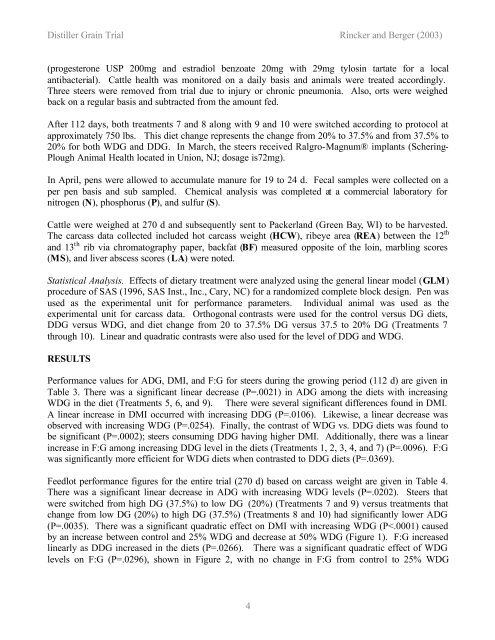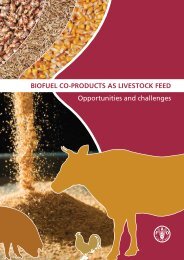Distillers Grains Feeding Recommendations. - Distillers Grains By ...
Distillers Grains Feeding Recommendations. - Distillers Grains By ...
Distillers Grains Feeding Recommendations. - Distillers Grains By ...
Create successful ePaper yourself
Turn your PDF publications into a flip-book with our unique Google optimized e-Paper software.
Distiller Grain Trial Rincker and Berger (2003)(progesterone USP 200mg and estradiol benzoate 20mg with 29mg tylosin tartate for a localantibacterial). Cattle health was monitored on a daily basis and animals were treated accordingly.Three steers were removed from trial due to injury or chronic pneumonia. Also, orts were weighedback on a regular basis and subtracted from the amount fed.After 112 days, both treatments 7 and 8 along with 9 and 10 were switched according to protocol atapproximately 750 lbs. This diet change represents the change from 20% to 37.5% and from 37.5% to20% for both WDG and DDG. In March, the steers received Ralgro-Magnum® implants (Schering-Plough Animal Health located in Union, NJ; dosage is72mg).In April, pens were allowed to accumulate manure for 19 to 24 d. Fecal samples were collected on aper pen basis and sub sampled. Chemical analysis was completed at a commercial laboratory fornitrogen (N), phosphorus (P), and sulfur (S).Cattle were weighed at 270 d and subsequently sent to Packerland (Green Bay, WI) to be harvested.The carcass data collected included hot carcass weight (HCW), ribeye area (REA) between the 12 thand 13 th rib via chromatography paper, backfat (BF) measured opposite of the loin, marbling scores(MS), and liver abscess scores (LA) were noted.Statistical Analysis. Effects of dietary treatment were analyzed using the general linear model (GLM)procedure of SAS (1996, SAS Inst., Inc., Cary, NC) for a randomized complete block design. Pen wasused as the experimental unit for performance parameters. Individual animal was used as theexperimental unit for carcass data. Orthogonal contrasts were used for the control versus DG diets,DDG versus WDG, and diet change from 20 to 37.5% DG versus 37.5 to 20% DG (Treatments 7through 10). Linear and quadratic contrasts were also used for the level of DDG and WDG.RESULTSPerformance values for ADG, DMI, and F:G for steers during the growing period (112 d) are given inTable 3. There was a significant linear decrease (P=.0021) in ADG among the diets with increasingWDG in the diet (Treatments 5, 6, and 9). There were several significant differences found in DMI.A linear increase in DMI occurred with increasing DDG (P=.0106). Likewise, a linear decrease wasobserved with increasing WDG (P=.0254). Finally, the contrast of WDG vs. DDG diets was found tobe significant (P=.0002); steers consuming DDG having higher DMI. Additionally, there was a linearincrease in F:G among increasing DDG level in the diets (Treatments 1, 2, 3, 4, and 7) (P=.0096). F:Gwas significantly more efficient for WDG diets when contrasted to DDG diets (P=.0369).Feedlot performance figures for the entire trial (270 d) based on carcass weight are given in Table 4.There was a significant linear decrease in ADG with increasing WDG levels (P=.0202). Steers thatwere switched from high DG (37.5%) to low DG (20%) (Treatments 7 and 9) versus treatments thatchange from low DG (20%) to high DG (37.5%) (Treatments 8 and 10) had significantly lower ADG(P=.0035). There was a significant quadratic effect on DMI with increasing WDG (P
















